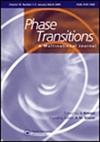Impact of calcination temperature on structural and optical properties of erbium-doped zinc ferrite nanoparticles
IF 1.4
4区 材料科学
Q3 CRYSTALLOGRAPHY
引用次数: 1
Abstract
ABSTRACT Erbium-doped zinc ferrite nanoparticles (ZnFe1.9Er0.1O4) were prepared by the sol–gel auto-combustion method. In order to study the impact of calcination temperature, the prepared powder was divided into four parts and calcinated at 700, 900, 1100 and 1300°C. XRD confirmed the formation of a spinel structure with a single phase and Fd3m space group. Crystallite size increased from 19.45 to 30.22 nm with the increase in calcination temperature. SEM images showed agglomerated flakes having voids and pores on the surface. The average grain size increased from 157.76 to 237 nm with the increase in calcination temperature. FTIR showed two fundamental absorption bands related to octahedral and tetrahedral sites along with other three absorption bands in the frequency range 400–4000 cm−1. The optical energy bandgap was increased from 3.8166 to 4.2779 eV with the increase of calcination temperature. Hence, it is concluded that the optical energy bandgap can be tuned with the calcination temperature.煅烧温度对掺铒铁酸锌纳米颗粒结构和光学性能的影响
摘要:采用溶胶-凝胶自燃烧法制备了掺铒铁酸锌纳米颗粒(znfe1.9 er0.10)。为了研究煅烧温度的影响,将制备好的粉体分成四份,分别在700、900、1100、1300℃下煅烧。XRD证实形成了具有单相和Fd3m空间基的尖晶石结构。随着煅烧温度的升高,晶粒尺寸由19.45 nm增大到30.22 nm。扫描电镜图像显示,团聚片表面有孔洞和孔隙。随着煅烧温度的升高,平均晶粒尺寸由157.76 nm增加到237 nm。在400-4000 cm−1的频率范围内,FTIR显示出与八面体和四面体位点相关的两个基本吸收带以及其他三个吸收带。随着煅烧温度的升高,光能带隙由3.8166 eV增大到4.2779 eV。由此得出,光能带隙可以随煅烧温度的变化而变化。
本文章由计算机程序翻译,如有差异,请以英文原文为准。
求助全文
约1分钟内获得全文
求助全文
来源期刊

Phase Transitions
物理-晶体学
CiteScore
3.00
自引率
6.20%
发文量
61
审稿时长
1.4 months
期刊介绍:
Phase Transitions is the only journal devoted exclusively to this important subject. It provides a focus for papers on most aspects of phase transitions in condensed matter. Although emphasis is placed primarily on experimental work, theoretical papers are welcome if they have some bearing on experimental results. The areas of interest include:
-structural phase transitions (ferroelectric, ferroelastic, multiferroic, order-disorder, Jahn-Teller, etc.) under a range of external parameters (temperature, pressure, strain, electric/magnetic fields, etc.)
-geophysical phase transitions
-metal-insulator phase transitions
-superconducting and superfluid transitions
-magnetic phase transitions
-critical phenomena and physical properties at phase transitions
-liquid crystals
-technological applications of phase transitions
-quantum phase transitions
Phase Transitions publishes both research papers and invited articles devoted to special topics. Major review papers are particularly welcome. A further emphasis of the journal is the publication of a selected number of small workshops, which are at the forefront of their field.
 求助内容:
求助内容: 应助结果提醒方式:
应助结果提醒方式:


